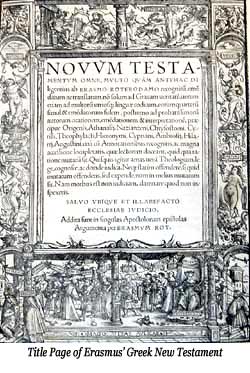Greek Text Behind the King James (Authorised Version)
 Question: Steve, I have been trying to find which Greek manuscripts underlie the Textus Receptus and KJV of the New Testament. I have read numerous articles that say Erasmus relied on only a few manuscripts, primarily on two, but none of them name the manuscripts he used. Can you tell me what they are please? Thanks very much. —Tom
Question: Steve, I have been trying to find which Greek manuscripts underlie the Textus Receptus and KJV of the New Testament. I have read numerous articles that say Erasmus relied on only a few manuscripts, primarily on two, but none of them name the manuscripts he used. Can you tell me what they are please? Thanks very much. —Tom
Answer: It's hard to give you an answer in a sentence or two. The basic facts are these:
Only six manuscripts
I found this in Bruce M. Metzger's The Text of the New Testament (Oxford, 1968): "Thus the text of Erasmus' Greek New Testament rests upon a half-dozen minuscule manuscripts. The oldest and best of these manuscripts (codex 1, a minuscule of the tenth century, which agrees often with the earlier uncial text) he used leased, because he was afraid of its supposedly erratic text!" (102). (Much of the rest of my answer is from the same source.)
After Cardinal Ximenes' Greek text came out a couple of years after Erasmus, Erasmus made corrections based on it. Then numerous printers reproduced the text of Erasmus in their own editions, sometimes making their own changes. One of these, the text of  Robert Estienne, Latinized as Stephanus, issued four editions (1546, 1549, 1550, and 1551). His third edition was the first to have a critical apparatus, in which he entered variant readings from 14 Greek codices, including the famous Codex Bezae, as well as readings from Ximenes' text.
Robert Estienne, Latinized as Stephanus, issued four editions (1546, 1549, 1550, and 1551). His third edition was the first to have a critical apparatus, in which he entered variant readings from 14 Greek codices, including the famous Codex Bezae, as well as readings from Ximenes' text.
Best manuscripts little used
The reformer Théodorè de Béze, or Beza, published four editions (1565, 1582, 1588-9, and 1598) and several reprints. His editions contained textual information from Greek manuscripts he personally collated, including his own Codex Bezae and Codex Claromontanus. Beza made little use of these manuscripts, however, for they deviated too far from the text generally received. He also garnered information from the Syriac and Arabic translations of the New Testament. All of this information Beza put into the margins of his editions; the text itself was the 1551 edition of Stephanus. Metzger says: "The King James translators of 1611 made large use of Beza's editions of 1588-9 and 1598."
Underlying text reconstructed
Only after the revision that culminated in the Revised Version of 1881 (=the ASV of 1901 with only minor differences) did F. H. A. Scrivener reconstruct the Greek text behind the KJV (The New Testament in the Original Greek According to the Text Followed in the Authorized Version Together with the Variations Adopted in the Revised Version [Cambridge, Eng.: Cambridge University Press, 1894). I happen to have a copy of his Greek Testament. In the preface he says, "[T]he Authorised Version was not a translation of any one Greek text then in existence, and no Greek text intended to reproduce in any way the original of the Authorised Version has ever been printed" (vii).
He goes on to say that they probably used Beza's 1598 edition "more... than any other Greek text" but...
There are however many placed in which the Authorised Version is at variance with Beza's text; chiefly because it retains language inherited from Tyndale or his successors, which had been founded on the text of other Greek editions. Wherever. the Authorised renderings agree with other Greek readings which might naturally be known through printed editions to the revisers of 1611 or their predecessors, Beza's reading has been displaced from the text in favour of the more truly representative reading. It was manifestly necessary to accept only Greek authority, though in some places the Authorised Version corresponds but loosely with any form of the Greek original, while it exactly follows the Latin Vulgate. All variations from Beza's text of 1598, in number about 190, are set down in an Appendix at the end of the volume, together with the authorities on which they respectively rest. (viii-ix)
It took strong convincing on the part of Westcott and Hort to move the revision committee away from the Textus Receptus in pursuit of an earlier text, found mainly in Codex Vaticanus and Codex Sinaiticus. That brought the underlying text of the New Testament back to a date of around 350-400 CE.
Modern text more ancient
Since about a hundred years ago, earlier and earlier manuscripts have been discovered, more than 100 papyri mainly from Egypt, taking the text back to around 175-200 CE.
Textual critics have found that the earlier manuscripts sometimes agree with Vaticanus and Sinaiticus against the medieval manuscripts, and sometimes disagree, but sometimes yield a third reading, not like either.
In trying to discern the original text, modern textual critics do not just count manuscripts as one would count votes in a popular election. If they did, the later manuscripts would win nearly every time, since there are more of them. Rather, they "weigh" the manuscripts, giving more weight to manuscripts that are older and those that generally have a better quality of text, based on established canons of internal criticism.
Eclectic textual critics
For the most part, however, modern textual critics are eclectic, which means they do not carefully follow one text family over its rivals but select variant by variant, verse by verse, which readings claim priority over their alternate readings.
There is a great deal of subjectivism in this process, for the hardest decisions are when the pros and cons are fairly evenly balanced.
The vast majority of textual decisions, however, make little or no difference in the overall meaning of the text. The UBS committee selected only 1200 readings for the entire New Testament that were both translationally significant and there was some degree of uncertainty about which reading to choose. This is a tiny number, and many of these involve word order, the absence or presence of an article, or other trivial differences.
» Post a Comment